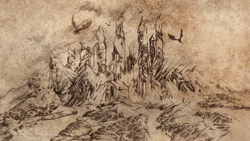Weas-El-Bot (talk | contribs) m (r2.7.10) (Bot: Adding es:Valyria, fr:Valyria, zh:瓦雷利亚) Tag: apiedit |
Tags: Visual edit apiedit |
||
| Line 49: | Line 49: | ||
===Surviving colonies in the [[Free Cities]]=== |
===Surviving colonies in the [[Free Cities]]=== |
||
| + | *[[Bravos]] |
||
*[[Lorath]] |
*[[Lorath]] |
||
*[[Lys]] |
*[[Lys]] |
||
Revision as of 15:43, 26 August 2015
- "Valyria" redirects here. For other related topics, including specifically the capital City of Valyria, see "Valyria (disambiguation)".
- "At its height, the Valyrian Freehold ruled over half the Known World, not bad for former shepherds . . ."
- ―Jorah Mormont

Old Valyria, City of Wonders
The Valyrian Freehold was the empire established by the Valyrian civilization in the continent of Essos, centered around the city of Valyria in the eponymous peninsula. At its height, the Valyrian Freehold covered over half of the known world.[1]
History
The Rise of Valyria
Thought to initially be a modest community of shepherds, the Valyrians rose to prominence five thousand years ago after they discovered dragons living in the Fourteen Fires, a string of volcanoes in the mountains of their homeland. After taming the mighty beasts, the Valyrians used them to conquer surrounding lands of the Valyrian Peninsula, and began expanding outwards.
The Ghiscari Empire, however, sought to halt Valyrian expansion and declared war on their neighbors from the opposite shore of Slaver's Bay. Massive Ghiscari slave-legions marched against Valyria in a series of five major wars, but each time they were defeated. The Freehold's forces then marched on the Ghiscari capital of Ghis and laid waste to it, leaving little more than a smoldering ruin behind and nearly erasing Ghiscari people and culture from history.
Afterward, the Valyrian Freehold became the dominant civilization in the known world, with its own language, religion and customs. The Freehold founded a number of colony cities, connected by a network of roads all of which led back to the capital city. Several of these colonies in the west became the Free Cities. They eventually came into conflict with the Rhoynar city-states along the Rhoyne River, leading to the Rhoynish Wars. The fighting culminated about one thousand years ago in the defeat of the Rhoynar and destruction of their cities, with the survivors fleeing in a mass migration led by Nymeria, whose refugee fleet eventually settled in Dorne in southeastern Westeros.
A few centuries ago, one of the great houses of Valyria, House Targaryen established the fortress of Dragonstone off the coast of the continent of Westeros, using it as a trading outpost of the Valyrian Freehold.
The Doom and Aftermath

Due to generations of inbreeding, the Targaryens retained distinctly Valyrian features: a pale complexion and white (platinum blonde) hair.
For nearly five thousand years, Valyrian supremacy remained uncontested. However, a cataclysmic event known as "The Doom" - a massive volcanic eruption of the Fourteen Fires - laid waste to the Valyrian capital, its people, and the surrounding lands. The Valyrian peninsula itself was shattered and the ocean came sweeping in, becoming the Smoking Sea. Dragons, as well as Valyrian recorded history, spells, and knowledge were lost. With its center of power destroyed, the empire collapsed. Of the mighty families of dragonlords who ruled the Freehold, only House Targaryen survived, as it had established Dragonstone far across the Narrow Sea years before the Doom.
The surviving colonies of the Valyrian Freehold split up into rival independent city-states. In the west, they became the Free Cities. In the east, the conquered Ghiscari cities of Slaver's Bay reasserted their independence, but five thousand years of Valyrian domination had swept away most of their original culture.
The ruins of Valyria in the Smoking Sea remain and are considered to be cursed by other civilizations. Some believe that 'the Doom still rules Valyria', inhabiting it with demons and preventing anyone from ever entering the ruins and emerging alive. In response to the disease known as greyscale, the cities of the east send those most affected by the plague, known as the Stone Men, to the ruins of Valyria to die. The advanced disease means that few, if any, of the Stone Men retain any lucid thought, becoming monstrous creatures who attack any who wander through Valyria.[2][3]
Cities
Ruined cities
Surviving colonies in the Free Cities
Surviving colonies in the Valyrian Peninsula
Surviving cities in Slaver's Bay
In the books
In the A Song of Ice and Fire novels, Valyria was neither a kingdom nor an empire: theoretically, all of the freeborn landholders ("free-holders") had equal say in government, hence the formal name of their government was the "Valyrian Freehold". In practice, however, this meant that it was essentially an oligarchy run by the wealthy noble families (there was no single emperor or king). There were about forty great families of wealth, high birth, and strong sorcerous ability, known as Dragonlords, that owned dragons and tended to dominate the rest. The Targaryens were one of these families, but far from the most powerful.
The Freehold not only conquered the Ghiscari Empire, but also the city-states of the Rhoynar people established around the Rhoyne river, leading to their exodus across the sea to Dorne. The modern Free Cities, as well as several others, were established as Valyrian colonies and became independent after the empire was shattered. The major exception to this is Braavos, located in the extreme northwest of Essos, which was founded by escaped slaves who fled Valyria, and remained hidden even long after the Doom. Braavos is thus sometimes referred to as the Bastard Son of Valyria.
See also
References
- ↑ "The Free Cities (Histories & Lore)"
- ↑ Sons of the Harpy
- ↑ Kill the Boy
